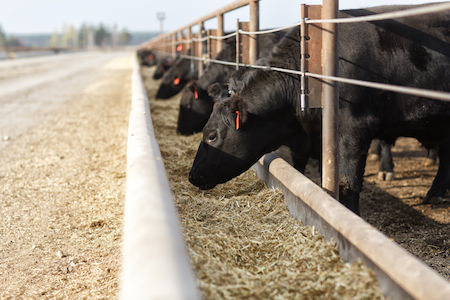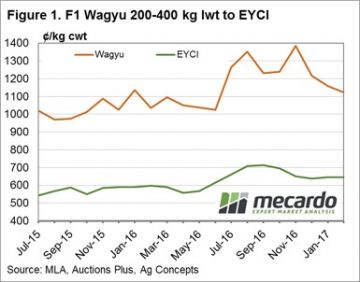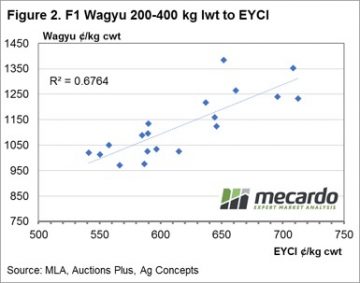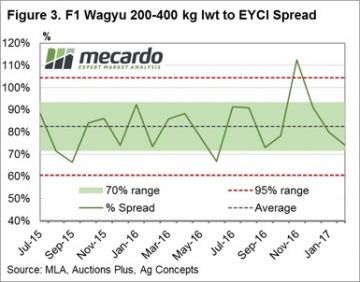May the force be Wagyu.

Key points:
- The broad price trend for F1 Wagyu steers and heifers mirrors the EYCI movements, with a moderately strong correlation between the two price series present.
- The average premium spread for F1 Wagyu over EYCI cattle since mid-2015 has been 83%.
- F1 Wagyu prices have spent most of the time trading 75-95% higher than the EYCI over the last few years.
 As it is international Star Wars day (May the fourth be with you) and the Australian Wagyu Association’s conference being held in Albury this week we couldn’t resist both the pun and the focus on Wagyu premiums over comparable young cattle, based off the Eastern Young Cattle Indicator (EYCI) underlying data.
As it is international Star Wars day (May the fourth be with you) and the Australian Wagyu Association’s conference being held in Albury this week we couldn’t resist both the pun and the focus on Wagyu premiums over comparable young cattle, based off the Eastern Young Cattle Indicator (EYCI) underlying data.
Figure 1 outlines the average monthly price for F1 Wagyu Steer and Heifers** weighing between 200-400kg lwt, according to AuctionsPlus data since July 2015, to comparable young cattle using the average monthly Eastern Young Cattle Indicator (EYCI) level. The price movements show a reasonably similar movement over time between the two series with the Wagyu F1 cattle, understandably, commanding a healthy premium over the EYCI.
While figure 1 shows the broad directional movements of the EYCI mirrored in the Wagyu price pattern an analysis of the correlations between the two price series shows a moderately strong positive relationship displaying an R squared of 0.67 – figure 2 (you can find a handy explanation of the R squared measure here). Essentially, this means that F1 Wagyu prices and the EYCI can be expected to move up and down in unison, more often than not.
 An analysis of the percentage spread that has been achieved by F1 Wagyu cattle within the same weight range of EYCI cattle shows an average premium of 83% has been attained since July of 2015 – figure 3. Although the percentage spread can vary at any given time the 70% range between a premium spread of 72%-94% (green band) highlights where the series has fluctuated for 70% of the time. The two red dotted lines between 61% to 104% give an indication of the 95% range (two standard deviations away from the average for the statistically minded reader) and gives an indication of when the spread is nearing historically extreme levels.
An analysis of the percentage spread that has been achieved by F1 Wagyu cattle within the same weight range of EYCI cattle shows an average premium of 83% has been attained since July of 2015 – figure 3. Although the percentage spread can vary at any given time the 70% range between a premium spread of 72%-94% (green band) highlights where the series has fluctuated for 70% of the time. The two red dotted lines between 61% to 104% give an indication of the 95% range (two standard deviations away from the average for the statistically minded reader) and gives an indication of when the spread is nearing historically extreme levels.
**The first cross of a Wagyu full blood 100% bull over another breed is referred to as an F1.
What does this mean?
 On average, the F1 Wagyu producer can expect to receive a premium spread between 75-95% above the EYCI most of the time. Recent discussions with Wagyu F1 producers indicated that forward basis agreements had been under negotiation with processors to determine an EYCI plus an agreed percentage spread as a settlement price when cattle were due for delivery. This historical spread analysis will give an idea of what type of premium for F1 Wagyu cattle above the EYCI is within a fair and reasonable range.
On average, the F1 Wagyu producer can expect to receive a premium spread between 75-95% above the EYCI most of the time. Recent discussions with Wagyu F1 producers indicated that forward basis agreements had been under negotiation with processors to determine an EYCI plus an agreed percentage spread as a settlement price when cattle were due for delivery. This historical spread analysis will give an idea of what type of premium for F1 Wagyu cattle above the EYCI is within a fair and reasonable range.


